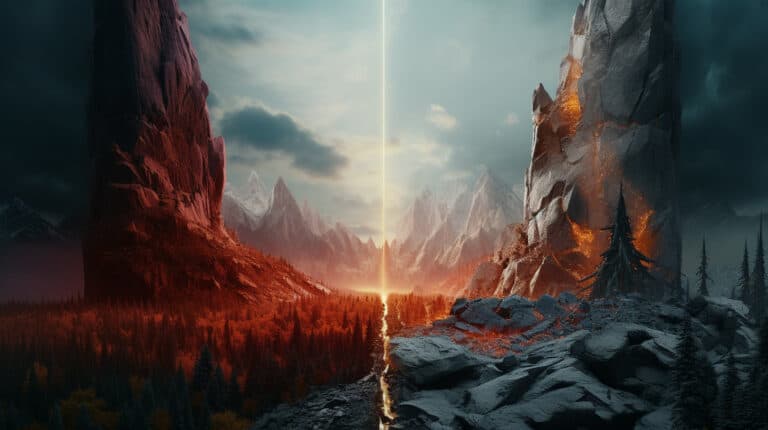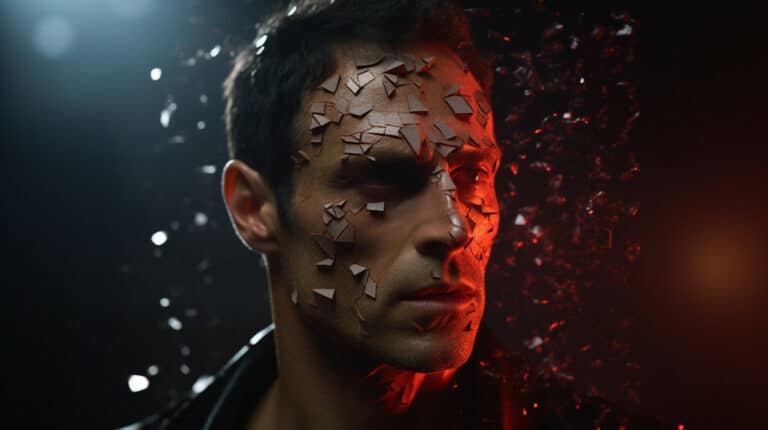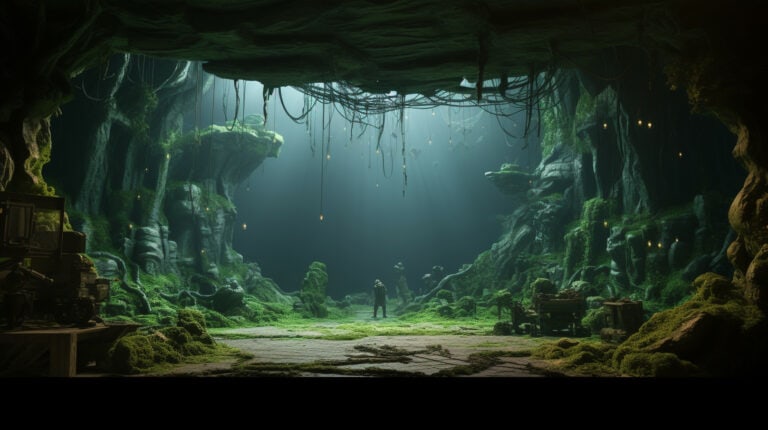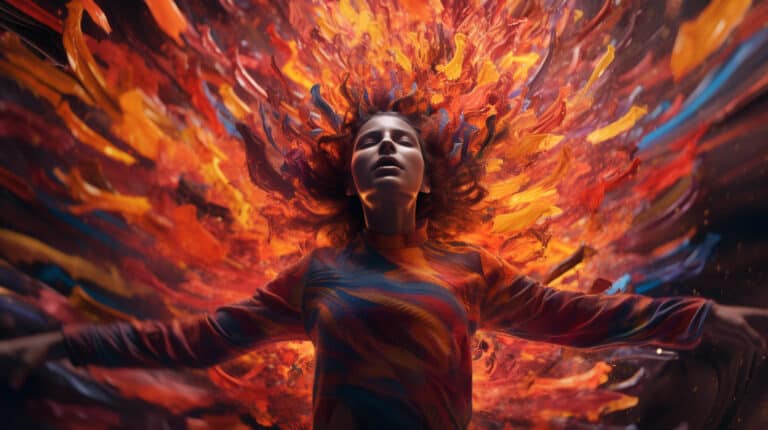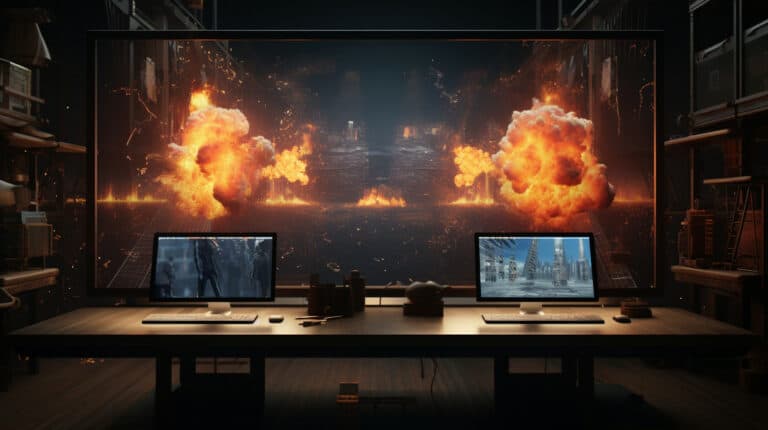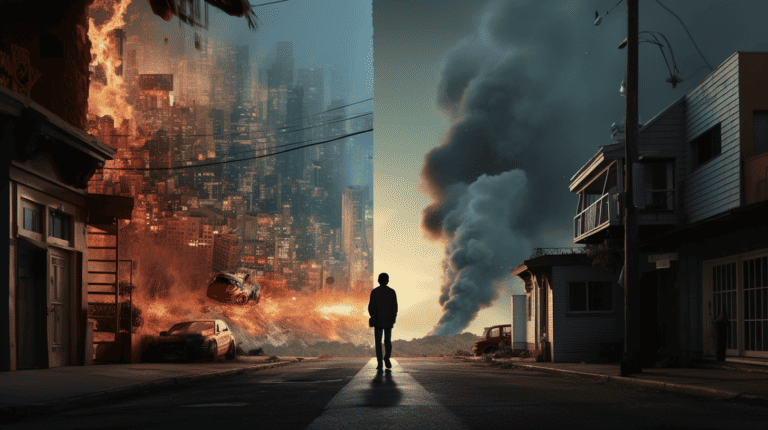VFX vs. CGI: Understanding the Differences and Impact
Do you ever wonder how movies create those jaw-dropping visual effects and mind-blowing CGI?
In this article, we will delve into the world of visual effects vs CGI, exploring their differences and the impact they have on the filmmaking industry.
From enhancing real-world elements to creating entirely digital worlds, we will unravel the key distinctions between the two.
Get ready to be amazed as we uncover the secrets behind these captivating techniques that leave audiences in awe.
Key Points:
- Visual effects and CGI are techniques used in the film industry to enhance the visual experience of the audience.
- Visual effects rely on practical techniques and manipulating real-world footage, while CGI is entirely computer-generated and allows for the creation of impossible elements.
- Visual effects and CGI have revolutionized filmmaking by expanding storytelling possibilities, creating realistic creatures and environments, and making it easier to depict historical events or futuristic worlds.
- The advancement of computer technology, motion capture technology, and the use of AI and machine learning have greatly contributed to the development of visual effects and CGI.
Importance of visual effects and CGI in the film industry
In the film industry, visual effects and CGI play a crucial role in enhancing the overall cinematic experience for audiences. These technological advancements have revolutionized the way stories are told on the big screen, creating stunning visuals that transport viewers to unimaginable worlds.
Here are three reasons why visual effects and CGI are of utmost importance in the film industry:
- Immersive storytelling: Visual effects and CGI allow filmmakers to bring their creative visions to life, immersing audiences in captivating and fantastical worlds that would otherwise be impossible to recreate.
- Realism and authenticity: With the help of visual effects and CGI, filmmakers can seamlessly integrate computer-generated elements into live-action footage, making the impossible appear real. This lends a sense of authenticity to the story, captivating audiences and making the experience more believable.
- Pushing creative boundaries: Visual effects and CGI enable filmmakers to push the boundaries of what’s possible in storytelling, allowing them to create mind-blowing action sequences, awe-inspiring creatures, and breathtaking landscapes.
By harnessing the power of visual effects and CGI, filmmakers can transport audiences to new realms and create truly unforgettable cinematic experiences.
Now, let’s delve into a brief explanation of visual effects and CGI.
A brief explanation of visual effects and CGI
You may frequently encounter visual effects and CGI in movies, but do you truly understand the differences and impact of these two technologies? Visual effects (VFX) and computer-generated imagery (CGI) are both essential tools used in filmmaking to create stunning and realistic visuals. However, there are distinct differences between the two.
VFX refers to the manipulation of real-life footage using various techniques, such as compositing, matte painting, and motion tracking. It involves enhancing or altering filmed scenes to create something that couldn’t be achieved during the actual filming process. On the other hand, CGI involves creating entirely digital elements from scratch, such as characters, creatures, or environments. It relies heavily on computer-generated graphics and animation.
To better understand the differences between visual effects and CGI, let’s take a look at the following table:
| Visual Effects (VFX) | Computer-Generated Imagery (CGI) |
|---|---|
| Enhances real-life footage | Creates digital elements from scratch |
| Manipulates filmed scenes | Relies on computer-generated graphics |
| Involves compositing, matte painting, motion tracking, etc. | Creates characters, creatures, environments, etc. |
| Adds visual enhancements | Produces realistic animations |
Visual effects and CGI play vital roles in modern filmmaking, allowing filmmakers to push the boundaries of creativity and immerse audiences in fantastical worlds. Understanding the differences between these two technologies can help us appreciate the incredible artistry and craftsmanship behind the movies we love.
I. Visual Effects: Enhancing Real-World Elements
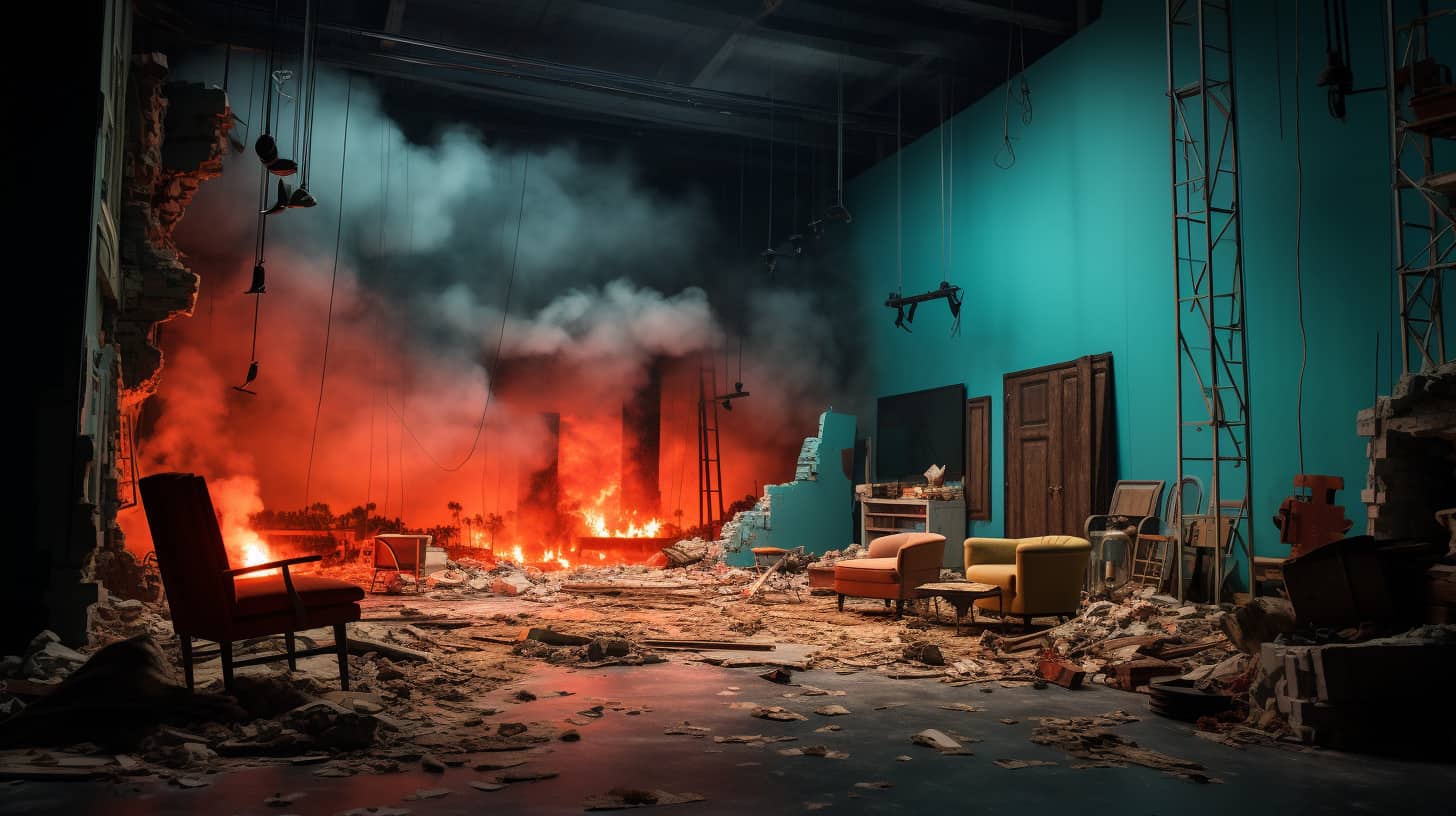
Ready to explore the world of visual effects? Get ready to be amazed by the magic of enhancing real-world elements on the big screen.
From breathtaking landscapes to jaw-dropping explosions, visual effects have been an integral part of cinema for decades.
Discover the definition, historical development, and examples of visual effects in popular movies that have captivated audiences worldwide.
Get ready to see reality transformed before your very eyes.
Definition and purpose of visual effects
Visual effects enhance the realism and visual appeal of real-world elements in films and television shows. They serve a crucial purpose in bringing imagination to life and creating immersive experiences for the audience.
Here are three reasons why visual effects are so important:
- Elevating storytelling: Visual effects can transport viewers to different worlds, eras, or dimensions, allowing storytellers to push the boundaries of their narratives. They help in conveying emotions, intensifying action sequences, and adding awe-inspiring visuals that captivate the audience.
- Enhancing believability: By seamlessly integrating computer-generated imagery (CGI) with live-action footage, visual effects make the impossible seem real. They breathe life into mythical creatures, create realistic environments, and make characters interact with fantastical elements, making the audience believe in the impossible.
- Enriching visual aesthetics: Visual effects can elevate the visual quality of a film or television show, making it visually stunning and memorable. They can enhance colors, textures, lighting, and overall cinematography, adding a layer of visual flair that captivates and immerses the audience in the story.
Historical development of visual effects in films
Imagine watching a film from the early days of cinema, where visual effects were limited to practical techniques and physical props. These early pioneers used their creativity and ingenuity to enhance real-world elements, bringing fantastical creatures and breathtaking landscapes to life.
As technology advanced, so did the world of visual effects, paving the way for digital effects that could seamlessly blend with live-action footage. From miniature models to CGI marvels, the historical development of visual effects has transformed the way we experience movies, taking us on extraordinary journeys beyond the boundaries of reality.
Early techniques and practical effects
As you delve into the historical development of visual effects in films, you’ll discover the early techniques and practical effects that played a crucial role in enhancing real-world elements. These techniques were born out of creativity and resourcefulness, pushing the boundaries of what was possible on screen.
They captivated audiences, sparking wonder and excitement. From miniatures that created breathtaking landscapes to matte paintings that transported viewers to fantastical worlds, these early visual effects laid the foundation for the immersive cinematic experiences we enjoy today.
Advancements in technology and digital effects
To continue exploring the historical development of visual effects in films, let’s delve into the advancements in technology and digital effects that have revolutionized the way real-world elements are enhanced on screen. From the early days of practical effects to the present, technology has played a crucial role in pushing the boundaries of visual storytelling. Take a look at the table below to see how some of these advancements have shaped the world of visual effects.
| Advancement | Impact |
|---|---|
| CGI | Allows for the creation of realistic and fantastical elements, expanding the possibilities of storytelling. |
| Motion Capture | Enables the seamless integration of live-action performances with computer-generated characters. |
| Virtual Reality | Immerses audiences in a whole new world, blurring the lines between the real and the digital. |
| Augmented Reality | Enhances real-world elements with digital overlays, creating interactive and immersive experiences. |
These advancements have not only transformed the way films are made but also opened up new avenues for creativity and imagination. As technology continues to advance, we can only imagine what the future holds for visual effects in the world of cinema.
Examples of visual effects in popular movies
Enhance the visuals of real-world elements in popular movies using visual effects. These stunning examples of visual effects will leave you in awe and make you appreciate the power of technology in filmmaking:
- Transforming the Ordinary: Witness everyday locations being transformed into extraordinary settings through visual effects. From turning a quiet street into a bustling city to creating breathtaking landscapes, visual effects can transport you to unimaginable worlds.
- Bringing Fantastical Creatures to Life: Visual effects breathe life into mythical creatures, making them appear as if they exist in our reality. From majestic dragons soaring across the sky to menacing aliens lurking in the shadows, these creations are brought to life with meticulous attention to detail.
- Epic Destruction and Explosions: Visual effects allow for jaw-dropping destruction on a grand scale. Witness buildings crumble, cities be destroyed, and explosions that shake the screen. These effects add intensity, drama, and excitement to action-packed sequences, leaving you on the edge of your seat.
Through the skillful use of visual effects, filmmakers are able to enhance reality and take audiences on unforgettable cinematic journeys.
II. CGI: Creating Entirely Digital Worlds
Now it’s time to enter the realm of CGI, where entire worlds are created and brought to life on the screen. But what exactly is CGI, and why is it such a game-changer in the film industry?
From its humble beginnings to its incredible evolution, CGI has transformed the way stories are told, pushing the boundaries of imagination and transporting audiences to unimaginable places.
Think about movies like Avatar or The Avengers, where CGI seamlessly blends with live-action, creating a visual spectacle that leaves us in awe.
Definition and purpose of CGI
CGI, or computer-generated imagery, is the process of creating entirely digital worlds in which you can immerse your audience. With this powerful technology, you have the ability to transport viewers to places that only exist in the imagination. Here’s why CGI is truly a game-changer:
- Limitless Creativity: CGI allows you to unleash your wildest imagination and create stunning visuals that were once unimaginable. From fantastical creatures to breathtaking landscapes, the possibilities are endless.
- Enhanced Realism: With advancements in CGI, you can achieve an unprecedented level of realism. Every detail, from the texture of a character’s skin to the movement of water, can be meticulously crafted to fool the eye and captivate the audience.
- Unexplored Worlds: CGI opens up new frontiers by bringing to life worlds that were previously unexplored. Whether it’s a distant planet, a futuristic city, or a magical realm, CGI enables you to create immersive experiences that transport viewers to extraordinary places.
As CGI continues to evolve, its impact on the film industry becomes even more profound. Let’s delve into the fascinating journey of CGI and its transformative role in movies.
Evolution of CGI in the film industry
Now let’s take a closer look at the evolution of CGI in the film industry and how it has revolutionized the creation of entirely digital worlds.
From its early use in films to the advancements in computer graphics and rendering techniques, CGI has come a long way in bringing imagination to life on the big screen.
With each new development, filmmakers have been able to push the boundaries of what’s visually possible, captivating audiences and immersing them in fantastical realms.
Early use of CGI in films
In the second phase of CGI’s evolution in the film industry, you witness the creation of entirely digital worlds. It’s a breathtaking leap forward, where filmmakers can transport you to fantastical realms that were previously unimaginable.
The possibilities are endless, from exploring alien planets to diving into the depths of the ocean. Prepare to be awestruck as CGI takes you on a journey beyond the limits of reality, where imagination knows no bounds.
Advancements in computer graphics and rendering techniques
Witness the breathtaking evolution of CGI in the film industry, as advancements in computer graphics and rendering techniques transport you to entirely digital worlds. The film industry has witnessed remarkable progress in CGI, allowing filmmakers to create immersive and visually stunning environments that were once thought impossible. With the use of powerful software and hardware, CGI has become an indispensable tool for filmmakers, enabling them to bring to life extraordinary worlds filled with awe and wonder.
| Advancements in CGI | Impact on the Film Industry | Examples |
|---|---|---|
| Realistic CGI characters and creatures | Enhanced storytelling and immersive experiences | Avengers: Endgame, The Jungle Book |
| Seamless integration of CGI and live-action footage | Expanded possibilities for storytelling and visual effects | The Lord of the Rings trilogy, Guardians of the Galaxy |
| Advanced physics and simulations | Realistic and dynamic action sequences | Gravity, The Matrix series |
As technology continues to advance, the boundaries of what can be achieved with CGI in the film industry are constantly being pushed. Filmmakers now have the ability to create worlds that were once only limited to the imagination. With each new film, CGI becomes more sophisticated and seamless, blurring the line between reality and fiction. It’s an exciting time for both filmmakers and audiences, as we witness the endless possibilities that CGI brings to the silver screen.
Examples of CGI in popular movies
You can explore the impact of CGI in popular movies by examining how entirely digital worlds are created. These virtual worlds, brought to life through the power of computer-generated imagery, have the ability to transport audiences to unimaginable realms.
Here are three astounding examples:
- ‘Avatar’ (2009): James Cameron’s groundbreaking film introduced us to the lush and vibrant world of Pandora. The CGI was so realistic that it felt like we were actually roaming the alien planet alongside the Na’vi.
- ‘Tron: Legacy’ (2010): This visually stunning sequel took us deep into the digital realm of the Grid. The film’s use of CGI created a mesmerizing neon-lit world that was both futuristic and nostalgic.
- ‘Ready Player One’ (2018): Steven Spielberg’s adaptation of Ernest Cline’s novel showcased the vast virtual reality world of the OASIS. The CGI brought to life countless characters and fantastical landscapes, immersing viewers in a world where anything was possible.
These movies demonstrate the transformative power of CGI in creating entirely digital worlds that captivate and awe audiences.
III. Key Differences between Visual Effects and CGI
So you want to know the key differences between visual effects and CGI?
Well, visual effects primarily focus on enhancing real-world elements, while CGI is all about creating entirely digital environments.
While both techniques contribute to the magic we see on screen, they employ different tools, processes, and techniques to achieve their respective goals.
Distinction between visual effects and CGI
One important distinction to understand between visual effects and CGI is the significant role that computer-generated imagery plays in creating realistic and immersive visual experiences. CGI allows filmmakers to generate computer-generated elements that seamlessly blend with real-world footage, enhancing the overall visual appeal of a film or television show.
Here are three reasons why CGI has such a powerful impact on the audience:
- Unlimited Creativity: CGI opens up a world of endless possibilities, enabling filmmakers to bring to life fantastical creatures, breathtaking landscapes, and awe-inspiring visual spectacles that would be impossible to achieve with practical effects alone.
- Enhanced Realism: With advancements in technology, CGI has become more realistic than ever before, allowing filmmakers to create lifelike characters, detailed environments, and mind-blowing special effects that transport the audience into another world.
- Immersive Storytelling: CGI enhances the storytelling experience by immersing the audience in visually stunning worlds, captivating their imagination, and creating emotional connections with the characters and the narrative.
Understanding the impact of CGI helps us appreciate the role that visual effects play in enhancing real-world elements, which will be discussed in the next section.
Role of visual effects in enhancing real-world elements
Additionally, visual effects play a crucial role in enhancing real-world elements by seamlessly integrating computer-generated elements with live-action footage. This blending of the virtual and the physical allows filmmakers to create breathtaking scenes that would otherwise be impossible to capture. Visual effects can transform ordinary locations into fantastical settings, transport characters to different time periods, or even bring mythical creatures to life. By adding digital elements to the real world, visual effects enhance the overall visual experience and immerse the audience in a world beyond their imagination.
To further illustrate the impact of visual effects in enhancing real-world elements, let’s take a look at the table below:
| Real-World Element | Visual Effect Enhancement |
|---|---|
| Landscapes | Add stunning backdrops and landscapes that are impossible to achieve in real life |
| Weather | Enhance natural phenomena like storms and hurricanes for heightened dramatic effect |
| Vehicles | Introduce futuristic or fantastical vehicles that do not exist in reality |
| Creatures | Bring mythical creatures to life, making them appear realistic and believable |
Through the use of visual effects, filmmakers are able to push the boundaries of reality and transport audiences to extraordinary worlds. It is this seamless integration of computer-generated elements with live-action footage that truly enhances the visual storytelling experience.
Role of CGI in creating entirely digital environments
CGI plays a pivotal role in creating entirely digital environments. With its advanced technology and capabilities, CGI has revolutionized the way filmmakers and visual effects artists bring imaginary worlds to life. Here are three reasons why CGI has such a profound impact on creating digital environments:
- Immersive Experience: CGI allows filmmakers to transport audiences into fantastical worlds that were once unimaginable. From alien planets to mythical realms, CGI helps create visually stunning environments that captivate and immerse viewers.
- Infinite Possibilities: With CGI, the only limit is the imagination. Filmmakers can create any setting they desire, no matter how fantastical or otherworldly. This opens up a world of endless possibilities, enabling the creation of unique and breathtaking digital environments.
- Seamless Integration: CGI seamlessly blends with live-action footage, allowing filmmakers to create environments that appear real and tangible. This level of integration enhances the overall cinematic experience, making it difficult to distinguish between what’s real and what’s digitally created.
CGI’s ability to create entirely digital environments pushes the boundaries of storytelling and transports audiences to worlds beyond their wildest dreams.
Comparison of techniques, tools, and processes used in visual effects and CGI
When comparing visual effects and CGI, it is important to understand the key differences in the techniques, tools, and processes used. Visual effects involve enhancing or manipulating footage that is already captured, while CGI (Computer Generated Imagery) creates entirely digital elements from scratch. The table below provides a concise breakdown of the main differences between the two:
| Visual Effects | CGI |
|---|---|
| Enhances or manipulates existing footage | Creates digital elements from scratch |
| Uses techniques like compositing, matte painting, and rotoscoping | Utilizes 3D modeling, texturing, and rendering |
| Relies on live-action footage as a starting point | Begins with a blank canvas |
| Requires extensive post-production work | Involves complete digital creation |
| Often used to seamlessly integrate real and digital elements | Used to create fantastical and imaginary worlds |
Understanding these differences can help you appreciate the complexity and artistry behind both visual effects and CGI. While visual effects enhance reality, CGI allows filmmakers to push the boundaries of imagination and create entirely new worlds.
IV. Advantages and Limitations of Visual Effects
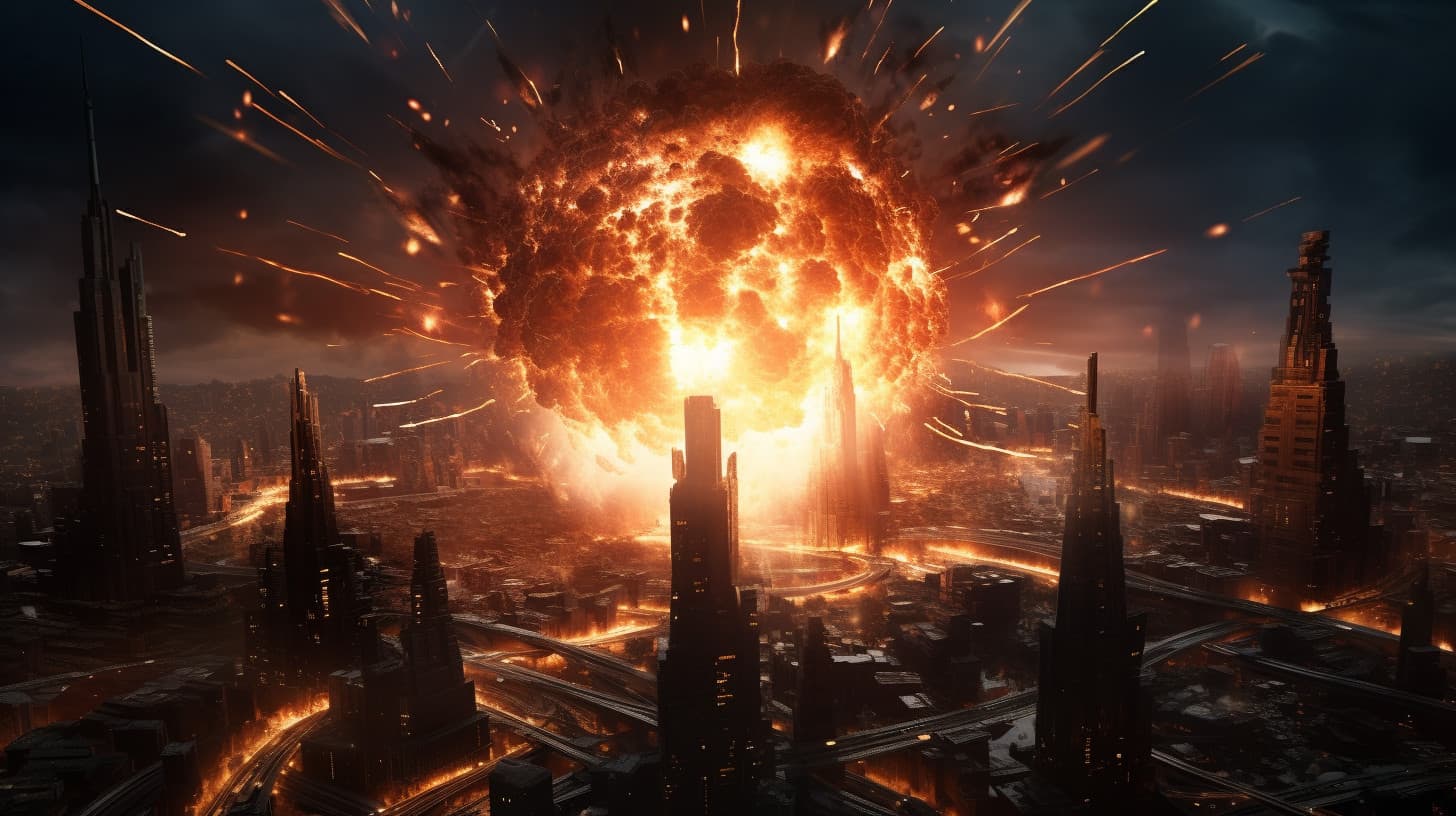
When it comes to using visual effects in films, there are several advantages that make them a valuable tool for filmmakers.
Visual effects allow for the creation of stunning and realistic scenes that would otherwise be impossible to capture.
However, it’s important to acknowledge that there are also limitations and challenges in the production of visual effects.
These limitations include the need for extensive planning, skilled artists, and a significant amount of time and resources.
Advantages of using visual effects in films
Imagine watching a film that transports you to a different world, where every detail feels real and every scene immerses you completely. Visual effects have the incredible ability to enhance realism and create truly immersive experiences, allowing filmmakers to bring their visions to life in ways that were once unimaginable.
Additionally, the flexibility of manipulating real-world elements through visual effects gives filmmakers the freedom to create breathtaking visuals and push the boundaries of storytelling. With these advantages, visual effects have become an indispensable tool in modern filmmaking, revolutionizing the way stories are told on the big screen.
Ability to enhance realism and create immersive experiences
One major advantage of using visual effects in films is their ability to enhance realism and create immersive experiences for the audience. This technology allows filmmakers to transport viewers to different worlds and make them feel like they’re part of the story.
With visual effects, you can witness breathtaking landscapes, jaw-dropping action sequences, and fantastical creatures that ignite your imagination. It’s a powerful tool that can evoke a range of emotions, from awe and wonder to fear and excitement.
Flexibility in manipulating real-world elements
To further understand the advantages of using visual effects in films, let’s explore the flexibility they offer in manipulating real-world elements.
Visual effects provide filmmakers with the ability to alter the environment, objects, and even characters in ways that were previously unimaginable. Want to create a massive explosion without endangering anyone? No problem. Need to make a location look like it’s in a different time period? Easy.
However, with this great power comes limitations and challenges in visual effects production.
Limitations and challenges faced in visual effects production
Are you ready to uncover the challenges and limitations that visual effects production faces?
While visual effects can enhance a film’s visual storytelling, they come with their fair share of obstacles.
The time-consuming and expensive nature of creating visual effects can put a strain on production schedules and budgets.
Additionally, integrating these effects seamlessly with live-action footage can be a complex and demanding task.
Let’s explore these limitations further and gain a deeper understanding of the world of visual effects.
Time-consuming and expensive nature of visual effects
Visual effects production can be a time-consuming and expensive process due to the intricate work involved in creating realistic visuals. It requires skilled artists, advanced software, and a significant amount of time to achieve the desired results. This can lead to long hours of work, tight deadlines, and high production costs.
The challenges faced in visual effects production highlight the dedication and commitment required to bring imagination to life on the screen. However, despite these limitations, the integration of visual effects with live-action footage presents its own set of challenges and possibilities.
Integration challenges with live-action footage
Integration of visual effects with live-action footage presents its own set of challenges and possibilities. The seamless blending of computer-generated imagery (CGI) with real-world footage requires careful attention to detail and precision. From matching lighting and camera angles to ensuring consistent color grading, every element must be meticulously executed to create a believable and immersive visual experience.
However, the process can also open up new creative avenues, allowing filmmakers to bring fantastical worlds and creatures to life in ways that were previously unimaginable.
V. Advantages and Limitations of CGI
When it comes to CGI in films, there are several advantages that make it a popular choice among filmmakers.
CGI allows for the creation of realistic and fantastical worlds, characters, and special effects that would otherwise be impossible to achieve.
However, there are also limitations and challenges that come with CGI production, such as the high cost and time-consuming nature of creating and rendering computer-generated images.
Balancing these advantages and limitations is crucial in order to effectively utilize CGI in film production.
Advantages of using CGI in films
When it comes to using CGI in films, the advantages are abundant. With CGI, you have the power to create fantastical and impossible worlds that would otherwise be impossible to achieve with traditional visual effects.
Not only that, but CGI gives you complete control over every aspect of the digital environment, allowing you to meticulously craft every detail to perfection.
The possibilities are truly endless with CGI, and it’s no wonder it has become such a vital tool in the film industry.
Ability to create fantastical and impossible worlds
You can frequently create fantastical and impossible worlds in films using CGI, providing a range of advantages for filmmakers.
- Immerse your audience in awe-inspiring environments that capture their imagination and transport them to new realms.
- Push the boundaries of reality, allowing for the creation of breathtaking landscapes and creatures that defy logic and physics.
- Bring to life epic battles and epic events that would be impossible to capture in real life, captivating your audience with larger-than-life spectacles.
With CGI, the possibilities are endless, and filmmakers can truly unleash their creativity to wow audiences like never before.
Control over every aspect of the digital environment
Filmmakers have complete control over every aspect of the digital environment when using CGI in films, allowing them to create stunning visuals and bring their creative vision to life.
With CGI, the possibilities are endless. From the tiniest details to the grandest landscapes, filmmakers can meticulously design each element to fit their narrative.
They can manipulate lighting, textures, and colors, ensuring that every frame is a work of art.
This level of control empowers filmmakers to transport audiences to worlds beyond imagination.
Limitations and challenges faced in CGI production
Are you curious about the limitations and challenges that CGI production faces? Well, let’s take a closer look.
One major obstacle is the high costs and time requirements involved in creating realistic CGI. It takes a significant investment of resources to achieve the level of detail and complexity needed for believable computer-generated imagery.
Additionally, there’s always the potential for the uncanny valley effect, where CGI characters or objects appear almost but not quite realistic, leading to a lack of authenticity and connection with the audience.
High costs and time requirements for creating realistic CGI
Creating realistic CGI involves significant investment in terms of both money and time. It’s a complex process that requires skilled professionals, advanced software, and cutting-edge technology. The high costs associated with CGI production can be daunting, especially for smaller studios or independent filmmakers.
Additionally, the time requirements for creating realistic CGI can be extensive, with meticulous attention to detail and multiple iterations. Despite these challenges, the end result can be awe-inspiring, immersing audiences in fantastical worlds and pushing the boundaries of visual storytelling.
Potential for uncanny valley and lack of realism
When working with CGI, it is important to be aware of the potential for the uncanny valley and the lack of realism it can create. The uncanny valley refers to the unsettling feeling that occurs when a CGI character or object looks almost but not quite human, leading to a sense of unease. This can make it challenging to achieve true realism in CGI production. To better understand the concept, let’s take a look at the following table:
| Level of Realism | Description | Examples |
|---|---|---|
| Low | Poorly textured, stiff movements | Early CGI in video games |
| Medium | Reasonably detailed, but still lacking in naturalness | CGI creatures in movies |
| High | Almost indistinguishable from reality | CGI environments in blockbusters |
As you can see, achieving high levels of realism in CGI can be incredibly difficult, often falling into the uncanny valley. However, advancements in technology continue to push the boundaries of what is possible, bringing us closer to the seamless integration of CGI with real-world elements.
Now, let’s explore how a collaborative approach between visual effects and CGI can help overcome these challenges and enhance the overall impact of a film or production.
VI. Collaborative Approach: Visual Effects and CGI Integration
When it comes to creating visually stunning films, the collaboration between visual effects and CGI teams is crucial.
The seamless integration of these two elements can elevate the overall quality and impact of a movie.
From epic battle scenes to breathtaking landscapes, successful examples of visual effects and CGI integration in films have shown us the power of this collaborative approach.
Importance of collaboration between visual effects and CGI teams
You need to actively collaborate between visual effects and CGI teams to ensure seamless integration and achieve stunning visual results. The importance of collaboration can’t be overstated. Here are three reasons why it’s crucial:
- Efficiency: When visual effects and CGI teams work together, they can streamline the production process, saving time and resources. By sharing their expertise and knowledge, they can identify potential issues early on and find innovative solutions.
- Creativity: Collaboration sparks creativity. When both teams come together, they can combine their skills and ideas to create breathtaking visuals that captivate audiences. Each team brings a unique perspective, and when they merge their talents, the possibilities are endless.
- Realism: Collaboration ensures that visuals seamlessly blend with the live-action footage. By working hand-in-hand, the visual effects and CGI teams can achieve a level of realism that transports viewers into the world of the film. This attention to detail enhances the overall cinematic experience.
Successful examples of visual effects and CGI integration in films
Imagine watching a movie where real-world elements seamlessly blend with CGI environments, creating a visually stunning and immersive experience. This is made possible through the collaborative approach of integrating visual effects and CGI.
By effectively using visual effects to enhance CGI creations, filmmakers can push the boundaries of storytelling and transport audiences to new worlds.
The successful examples of this integration demonstrate the power of collaboration and the limitless possibilities of combining practical and digital effects.
Seamless blending of real-world elements with CGI environments
Achieving a seamless blending of real-world elements with CGI environments requires a collaborative approach between visual effects and CGI, as demonstrated by successful examples in films. This integration not only creates visually stunning scenes but also elicits powerful emotional responses from the audience.
Here are three examples of how this collaborative approach has resulted in unforgettable cinematic moments:
1) The breathtaking fusion of live-action footage and computer-generated creatures in ‘Life of Pi’ evokes a sense of awe and wonder.
2) The seamless integration of CGI environments with real-world settings in ‘The Jungle Book’ transports viewers to a vibrant and immersive world.
3) The realistic and emotionally impactful portrayal of dinosaurs in ‘Jurassic Park’ leaves audiences on the edge of their seats.
Effective use of visual effects to enhance CGI creations
To effectively enhance CGI creations, the collaborative integration of visual effects and CGI has yielded impressive results in various films. By seamlessly blending real-world elements with computer-generated imagery, filmmakers have been able to create stunning and immersive visual experiences.
From the breathtaking landscapes of Pandora in ‘Avatar’ to the lifelike characters in ‘The Jungle Book,’ this collaborative approach has pushed the boundaries of what’s possible in the world of CGI.
The marriage of visual effects and CGI has revolutionized the way stories are brought to life on the big screen, captivating audiences and transporting them to extraordinary worlds.
VII. Impact on Filmmaking and Audience Experience
As a moviegoer, you may not realize the immense influence that visual effects and CGI have on the storytelling experience. These technological advancements have allowed filmmakers to bring to life worlds and creatures that were once unimaginable.
As a result, audience expectations and demands have evolved, with viewers now craving more immersive and visually stunning experiences. The impact of visual effects and CGI on filmmaking is undeniable, shaping the way stories are told and enhancing the overall audience experience.
Influence of visual effects and CGI on storytelling
With the advancements in visual effects and CGI, you can now immerse yourself in the storytelling of films like never before. These technological marvels have revolutionized the way stories are told, allowing filmmakers to transport you to fantastical worlds, evoke visceral emotions, and create mind-bending experiences.
Here are three ways visual effects and CGI have influenced storytelling:
- Creating stunning and realistic visuals: From breathtaking landscapes to awe-inspiring creatures, visual effects and CGI bring the director’s vision to life, captivating your senses and enhancing the narrative.
- Expanding the realm of imagination: With visual effects and CGI, filmmakers can push the boundaries of what’s possible, taking you on extraordinary adventures and introducing you to unimaginable characters and scenarios.
- Deepening emotional connections: Visual effects and CGI enable filmmakers to evoke powerful emotions and connect with audiences on a profound level. Whether it’s the heart-pounding excitement of an action sequence or the heart-wrenching sorrow of a dramatic moment, these technologies amplify the impact of storytelling.
As the influence of visual effects and CGI continues to grow, it has sparked an evolution in audience expectations and demands. [Transition sentence into the subsequent section about ‘evolution of audience expectations and demands’]
Evolution of audience expectations and demands
As a moviegoer, you’ve probably noticed the increasing reliance on visual effects and CGI in modern films. From breathtaking landscapes to fantastical creatures, these digital enhancements have become an integral part of our cinematic experience.
However, filmmakers also understand the importance of striking a balance between practical effects and CGI, ensuring that the audience is still able to connect with the tangible and authentic elements of a film.
Increasing reliance on visual effects and CGI in modern films
You frequently encounter an increasing reliance on visual effects and CGI in modern films, which has transformed audience expectations and demands. This shift has had a profound impact on the way movies are made and experienced. Here are three reasons why this trend has evoked strong emotional responses from audiences:
- Immersion: The realistic visual effects and CGI transport viewers into fantastical worlds, making them feel like active participants in the story.
- Spectacle: The jaw-dropping visuals create awe and excitement, leaving audiences craving more thrilling and visually stunning experiences.
- Innovation: The constant push for better and more advanced effects pushes the boundaries of creativity, captivating audiences with groundbreaking visuals they’ve never seen before.
As visual effects and CGI continue to evolve, the expectations and demands of audiences will only grow, challenging filmmakers to push the limits of their imagination and technical prowess.
Balancing practical effects with digital enhancements
Now, let’s delve into the impact of balancing practical effects with digital enhancements on filmmaking and audience experience.
Finding the right balance between practical effects and digital enhancements is crucial in creating a believable and immersive cinematic experience. While practical effects add a tactile and authentic feel to a scene, digital enhancements allow for limitless possibilities and seamless integration.
The challenge lies in using these tools together to enhance storytelling without overshadowing the narrative or disconnecting the audience from the film’s world.
VIII. Future Trends and Innovations in Visual Effects and CGI
As technology continues to advance at an exponential rate, the future of visual effects and CGI holds immense potential. These advancements are shaping the landscape of the film industry and opening up new creative possibilities for filmmakers.
From hyper-realistic virtual environments to the seamless integration of live-action and digital elements, the future of visual effects and CGI is set to revolutionize the way stories are told on the silver screen.
Advancements in technology shaping the future of visual effects and CGI
Get ready to be blown away by the advancements in technology that are shaping the future of visual effects and CGI. Real-time rendering has revolutionized the industry, allowing for instant feedback and increased efficiency.
And with the integration of AI and machine learning, the possibilities are endless for creating even more realistic and immersive visual experiences.
The future is here, and it’s bringing us closer to a world where anything is possible on the big screen.
Real-time rendering and virtual production techniques
In the future of visual effects and CGI, you can expect advancements in technology to shape real-time rendering and virtual production techniques. These innovations will revolutionize the way movies, video games, and virtual reality experiences are created.
Imagine being able to see your favorite characters come to life in real time, with intricate details and stunning visual effects.
Picture yourself stepping into a virtual world that feels so real you’ll forget it’s all just pixels on a screen.
Get ready for a future where imagination meets reality.
Integration of AI and machine learning in visual effects and CGI
The integration of AI and machine learning is revolutionizing the future of visual effects and CGI. These technologies are enabling filmmakers to create stunning and realistic effects that were once impossible.
AI algorithms can analyze vast amounts of data to generate lifelike characters, simulate realistic physics, and enhance the overall visual quality of scenes.
Machine learning algorithms can also learn from existing footage to automate certain aspects of the visual effects process, saving time and effort.
The possibilities are endless, and the future of visual effects and CGI is certainly exciting.
Potential impact on the film industry and creative possibilities
With the constant advancements in visual effects and CGI, you can expect a significant impact on the film industry and endless creative possibilities. Here are three ways these technologies are shaping the future of filmmaking:
- Immersive storytelling: Visual effects and CGI allow filmmakers to transport audiences to fantastical worlds, creating immersive experiences that were once unimaginable. From breathtaking landscapes to jaw-dropping action sequences, these technologies push the boundaries of storytelling, captivating viewers like never before.
- Enhanced realism: With the advancements in visual effects and CGI, filmmakers can now create incredibly realistic characters and environments. From lifelike creatures to detailed historical reconstructions, these technologies bring stories to life in ways that were previously only possible in our imaginations.
- Cost-effective production: Visual effects and CGI offer cost-effective solutions for filmmakers, enabling them to create elaborate scenes without the need for physical sets or expensive practical effects. This opens up doors for independent filmmakers and allows for more ambitious projects to come to fruition.
As visual effects and CGI continue to evolve, the future of filmmaking holds endless opportunities for creativity and innovation. From mind-bending visual spectacles to emotionally resonant narratives, these technologies are revolutionizing the way stories are told, leaving audiences in awe and anticipation for what’s to come.
Conclusion
Now that you have a clear understanding of the key differences between visual effects and CGI, it’s time to appreciate their immense importance in modern filmmaking.
Visual effects and CGI have revolutionized the way stories are told on the big screen, allowing filmmakers to transport audiences to unimaginable worlds and bring their wildest imaginations to life.
Looking ahead, the future of visual effects and CGI holds even more exciting possibilities as advancements in technology continue to push the boundaries of creativity and immerse viewers in truly awe-inspiring cinematic experiences.
Recap of the key differences between visual effects and CGI
To recap the key differences between visual effects and CGI, you need to understand their distinct roles in enhancing the overall impact of a film or video.
- Visual effects: These are practical effects created during the production process, using physical elements, props, and sets. They bring a tangible and authentic feel to the scenes, immersing the audience in the story.
- CGI (Computer-Generated Imagery): This involves the use of computer software to generate lifelike visuals that are impossible or difficult to create practically. CGI allows for limitless creativity and enables filmmakers to bring fantastical creatures, breathtaking landscapes, and epic battles to life.
- Impact: Visual effects and CGI work together to create a seamless and immersive visual experience. While visual effects provide a sense of realism, CGI expands the boundaries of imagination. Combined, they transport the audience to new worlds, evoke emotions, and make storytelling more powerful.
Understanding the differences between visual effects and CGI allows filmmakers to leverage these techniques effectively, resulting in visually stunning and emotionally captivating films.
Importance of visual effects and CGI in modern filmmaking
How do visual effects and CGI contribute to the significance of modern filmmaking? These technological advancements have revolutionized the way stories are brought to life on the big screen.
Visual effects allow filmmakers to create fantastical worlds and creatures that were once unimaginable, captivating audiences and enhancing the overall cinematic experience.
With CGI, filmmakers can seamlessly blend real-life footage with computer-generated elements, blurring the line between reality and fiction. This enables the creation of breathtaking action sequences, mind-bending visual spectacles, and immersive environments that transport viewers to new realms.
Moreover, visual effects and CGI have made it possible to realize the vision of visionary directors who strive to push the boundaries of storytelling. They’ve become an integral part of modern filmmaking, elevating films to new heights of creativity and realism.
The future of visual effects and CGI in pushing creative boundaries
Pushing creative boundaries in the future, visual effects and CGI will continue to evolve and amaze audiences with their endless possibilities. Here are three reasons why the future of visual effects and CGI is something to be excited about:
- Immersive storytelling: With advancements in technology, visual effects, and CGI will enable filmmakers to create even more immersive and captivating worlds. Imagine being transported to distant planets or experiencing historical events firsthand. The possibilities for storytelling are limitless.
- Enhanced realism: As visual effects and CGI continue to improve, the line between what’s real and what’s computer-generated will become increasingly blurred. This means that filmmakers will be able to create incredibly realistic and believable scenes, making it easier for audiences to suspend their disbelief and fully immerse themselves in the story.
- Unleashing imagination: Visual effects and CGI have the power to bring the wildest imaginations to life. From fantastical creatures to mind-bending visuals, the future of visual effects and CGI will allow filmmakers to unleash their creativity and take audiences on unforgettable journeys.
Frequently Asked Questions
What Is the History of Visual Effects and CGI in Filmmaking?
In filmmaking, the history of visual effects and CGI is fascinating. Over the years, they have evolved and revolutionized the way movies are made. Let’s dive into their journey and discover their impact on the big screen.
How Do Visual Effects and CGI Impact the Budget of a Film?
Visual effects and CGI can have a significant impact on a film’s budget. By using these techniques, you can create stunning visuals and bring imaginative worlds to life, but it can also be costly to produce and require precise planning to stay within budget.
Can Visual Effects and CGI Be Used Interchangeably in Films?
Visual effects and CGI cannot be used interchangeably in films. Visual effects encompass various techniques, while CGI specifically refers to computer-generated imagery. Understanding the differences between the two is crucial for achieving the desired impact in a film.
What Are Some Examples of Films That Heavily Rely on Visual Effects or CGI?
In films today, there are numerous examples of movies that heavily rely on visual effects or CGI. These stunning creations transport you to new worlds and create jaw-dropping spectacles that leave you in awe.
How Has the Advancement of Technology Influenced the Field of Visual Effects and CGI?
The advancement of technology has greatly influenced the field of visual effects and CGI. You’ll be amazed at how realistic and immersive the effects have become, creating a whole new level of cinematic experience.


